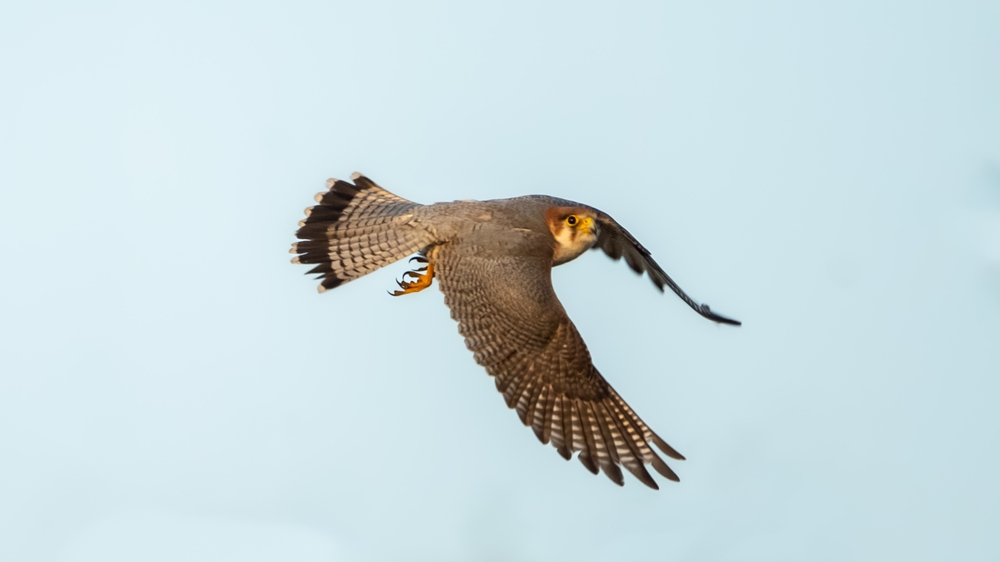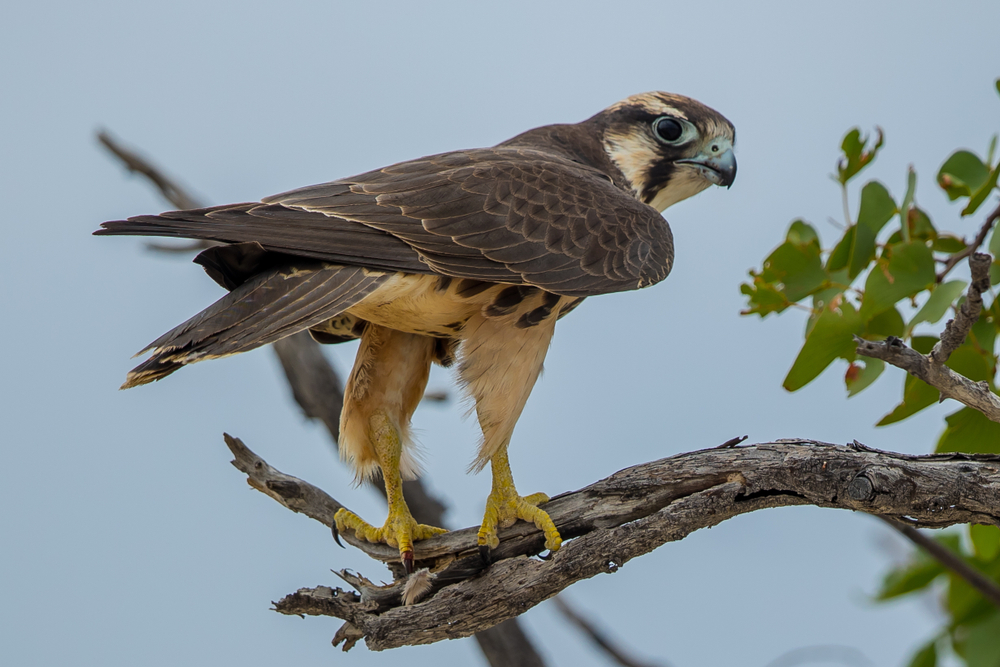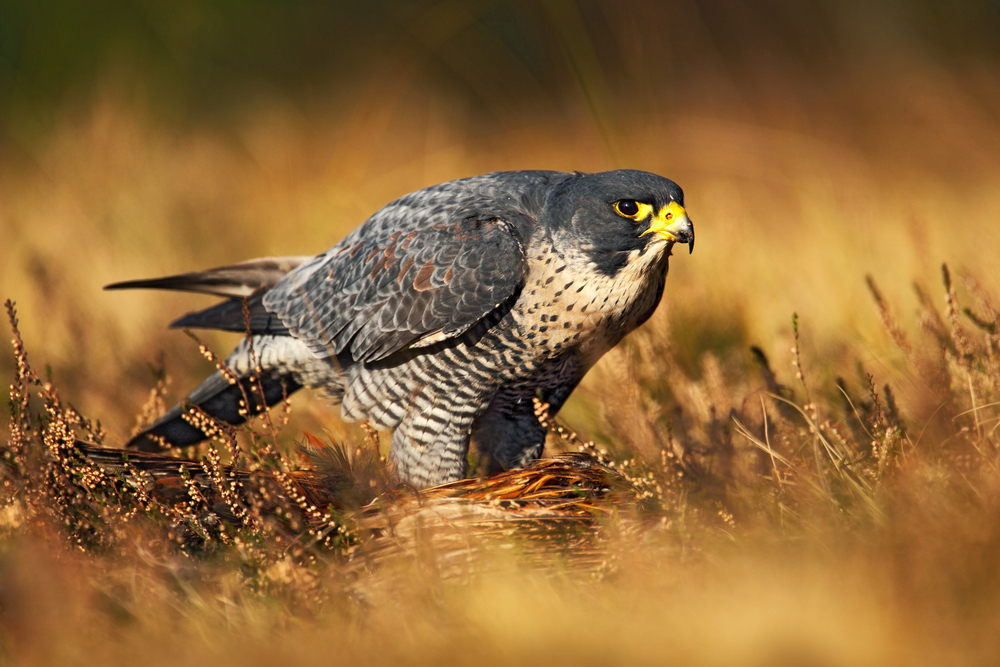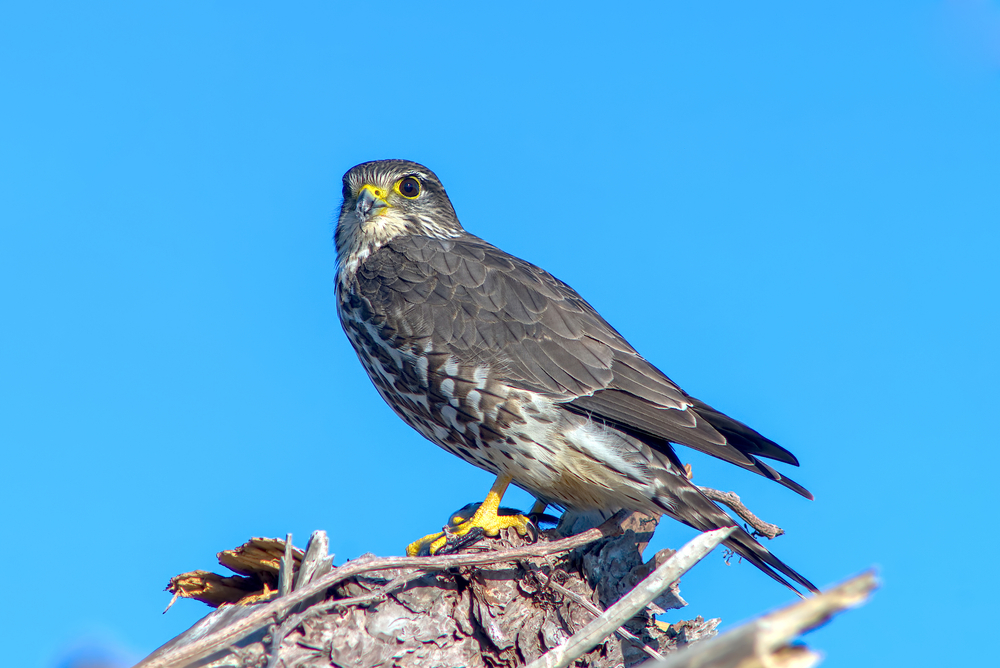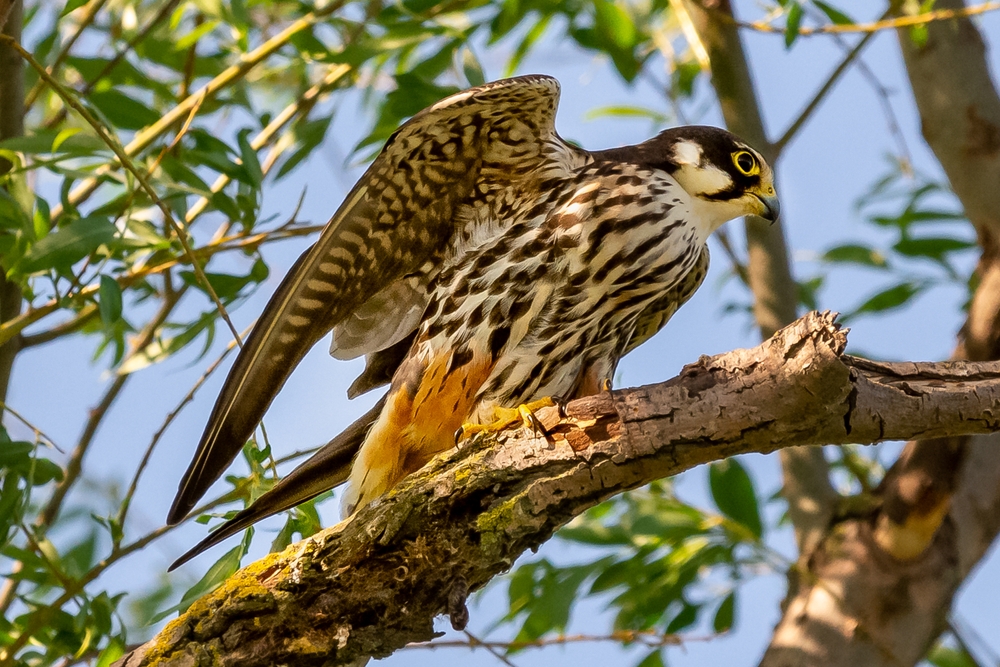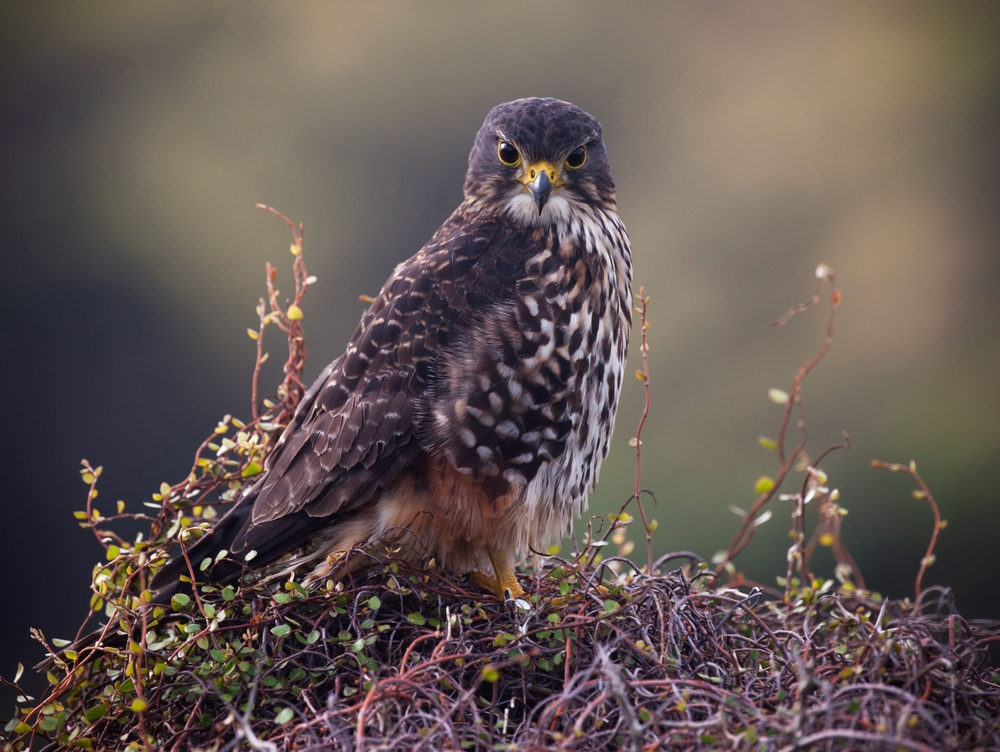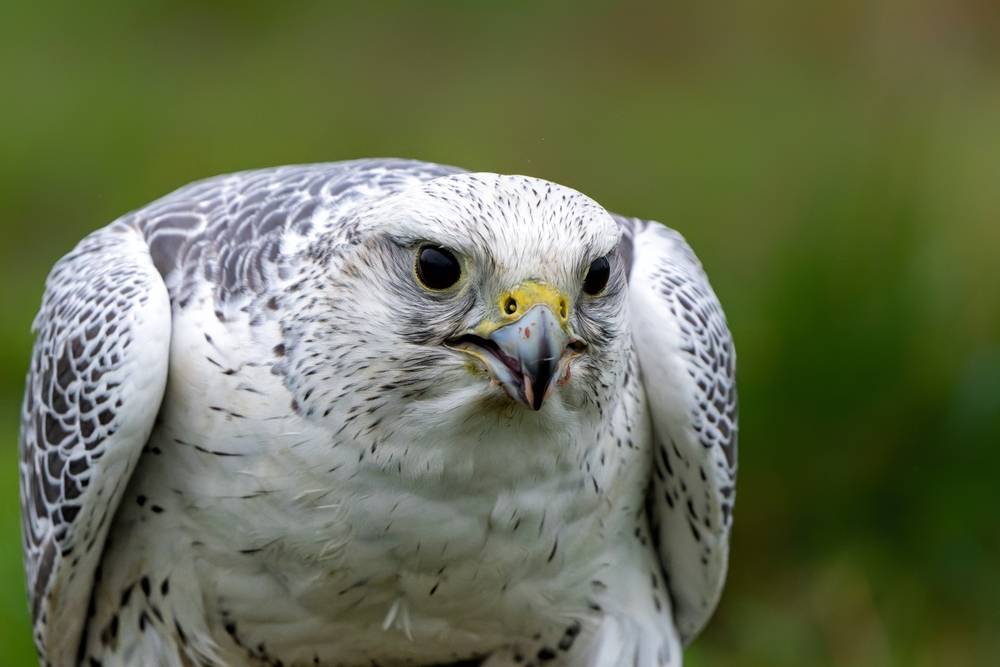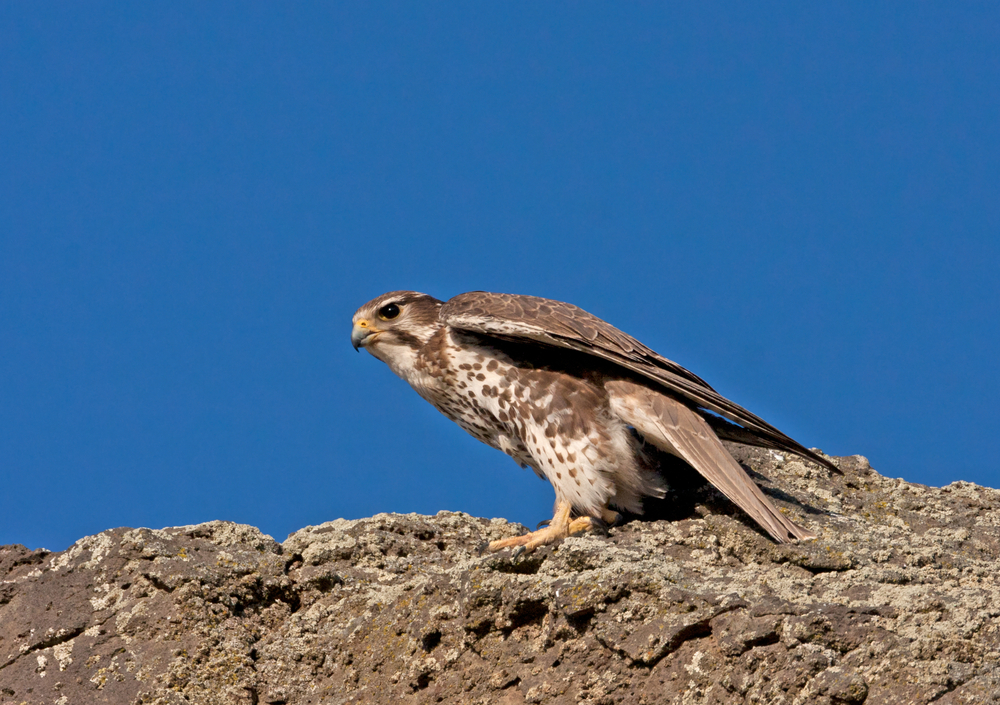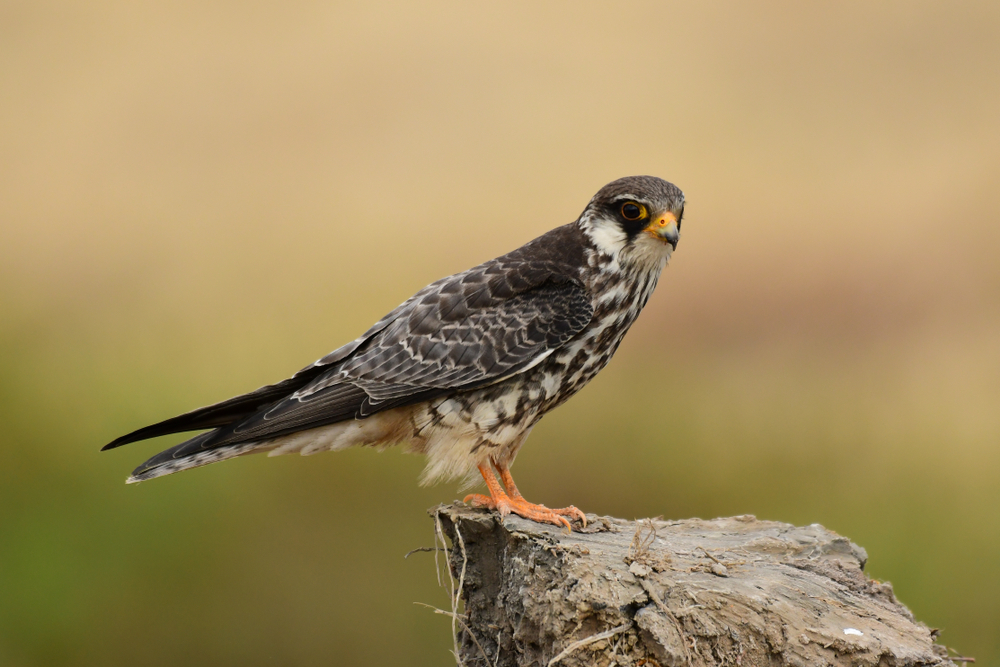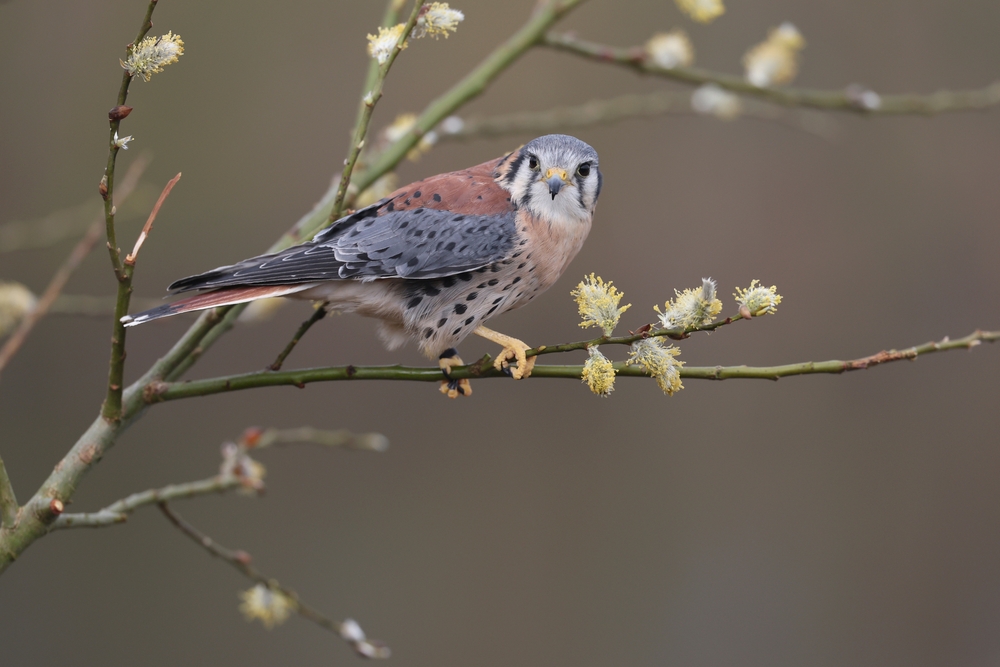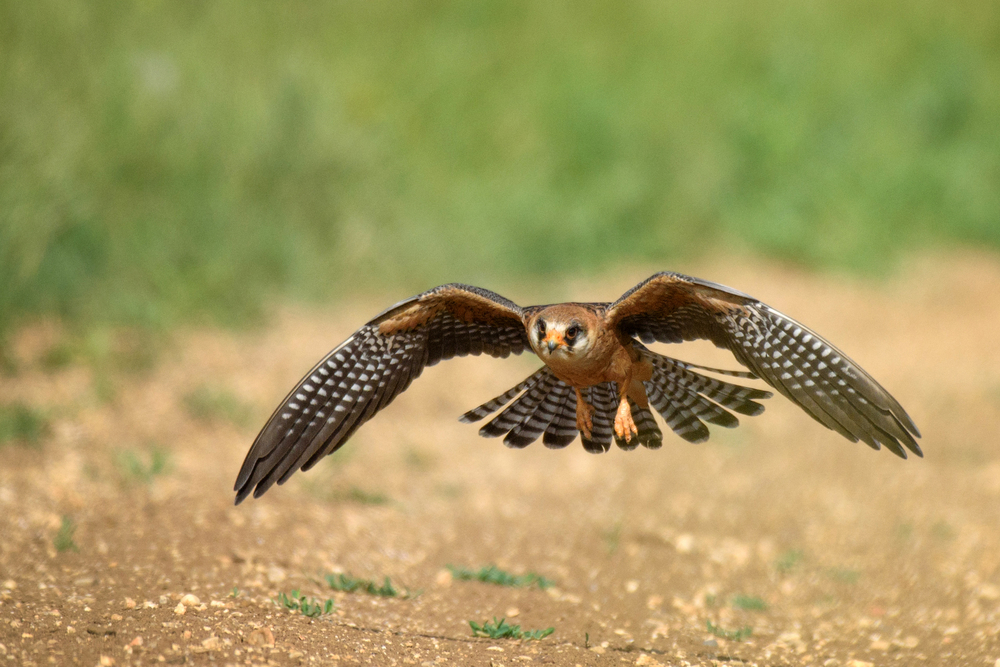The Red-necked Falcon (Falco chicquera) is most closely related to the Lanner Falcon (Falco biarmicus), sharing similarities in size, plumage, and hunting strategies, particularly cooperative pair hunting in open-country habitats.
About
The Red-necked Falcon (Falco chicquera), belonging to the Falconidae family, is a medium-sized falcon native to sub-Saharan Africa and parts of the Indian subcontinent. Known for its striking appearance and rapid, acrobatic hunting style, this species thrives in savannas, open woodlands, and cultivated areas where prey is abundant.
True to its name, the Red-necked Falcon has a distinct rufous crown and nape, contrasting sharply with its pale face marked by bold dark “moustache” stripes. Its upperparts are bluish-gray, while the underparts are whitish with fine rufous streaking. With a body length of 30–36 cm (12–14 in) and a wingspan of 65–80 cm (26–31 in), it is similar in size to the Eurasian Hobby but more robust in build.
This falcon is an agile and determined hunter, often flying low and fast in pursuit of prey. Its diet consists mainly of small birds, such as doves and pigeons, as well as insects and occasionally small mammals. Unlike some falcons that rely on stooping dives from great heights, the Red-necked Falcon is adept at ground-level chases, using speed and persistence to overwhelm prey.
Breeding typically occurs in old stick nests of crows or other raptors, often situated high in trees. Clutches usually contain 2–4 eggs, and both parents share incubation and chick-rearing responsibilities. The species is known for its devotion to nest defense, boldly confronting much larger intruders that approach too closely.
Culturally, the Red-necked Falcon has long been admired in India, where it was historically trained in falconry for its speed and effectiveness in hunting. While it remains fairly widespread, local populations face pressures from habitat destruction, pesticide use, and human encroachment. Nevertheless, it continues to be considered a species of Least Concern due to its broad distribution.
Physical Characteristics
The Red-necked Falcon (Falco chicquera), also known as the Turumti Falcon, is a medium-sized falcon native to South Asia and sub-Saharan Africa, known for its striking head and rufous tones.
Plumage:
-
Adults: Pale gray upperparts with fine barring on the wings and back, contrasting with white underparts streaked or spotted with dark markings. The head and nape are a rich rufous-red, giving the species its name.
-
Juveniles: Duller than adults, with browner plumage above and heavier streaking below. The red tones on the head and nape are less vivid.
Head and Face:
The most distinctive feature is the rufous crown and nape, contrasting sharply with the white throat and face. A thin dark moustache stripe extends downward from the eye.
Body and Wings:
The body is slim and streamlined, built for speed. Wings are long, pointed, and powerful, enabling fast aerial pursuit of birds in open landscapes.
Tail:
The tail is long, gray, and barred with darker bands, ending in a broader black subterminal band and white tip for balance and precision in flight.
Size:
-
Length: 11–14 in (30–36 cm)
-
Wingspan: 26–33 in (65–84 cm)
-
Height at Rest: About 12 in (30 cm) when perched
Weight:
-
Adult Male: 5.6–7.4 oz (160–210 g)
-
Adult Female: 8.1–12 oz (230–340 g)
The Red-necked Falcon’s vivid rufous head, white underparts, and long, banded tail make it one of the most colorful and easily recognized falcons of Africa and South Asia. Its elegant form and swift, direct flight are perfectly adapted to open-country hunting.
Reproduction
The Red-necked Falcon (Falco chicquera) breeds across South Asia and sub-Saharan Africa, with a reproductive cycle aligned to regional dry seasons and prey availability.
1. Mating and Courtship:
Pairs are monogamous and often remain together for multiple years. Courtship involves aerial displays, calling, and food offerings, with males frequently passing prey to females mid-air.
2. Nesting Sites:
They do not build their own nests. Instead, Red-necked Falcons typically reuse old stick nests of crows, kites, or other raptors, placed in tall trees, palms, or occasionally on cliffs. They prefer nesting sites close to open hunting grounds.
3. Egg Laying:
The female lays 2–4 eggs per clutch, usually during the dry season when prey is more abundant. Eggs are buff to cream-colored with reddish-brown speckles.
4. Incubation:
The incubation period lasts about 28–30 days, with the female performing most of the incubation while the male hunts and provides food.
5. Hatching and Care of Chicks:
Chicks hatch with white down and are entirely dependent on the parents. The female broods them during the first couple of weeks, while the male supplies food. As they grow, both parents share in feeding the young.
6. Fledging and Independence:
Young falcons fledge at about 30–35 days old. They remain near the nest and depend on their parents for hunting support and food for several more weeks.
7. Breeding Frequency:
Most pairs raise one brood per year, though replacement clutches may be laid if the first attempt fails early.
The Red-necked Falcon’s reliance on reused nests, strong pair bonds, and timing of breeding with prey abundance help ensure reproductive success in its semi-arid and savanna habitats.
Lifespan
The Red-necked Falcon (Falco chicquera) has a moderate lifespan for a medium-sized falcon, with survival depending heavily on habitat quality and prey availability in its semi-arid and savanna range.
Lifespan in the Wild:
In the wild, Red-necked Falcons generally live 8–12 years. Many juveniles do not survive their first year due to predation, food scarcity, or nesting failures. The oldest wild individuals may reach 14 years.
Lifespan in Captivity:
With consistent food, protection from predators, and veterinary care, Red-necked Falcons can live 15–18 years in captivity.
Threats to the Red-necked Falcon:
-
Predation: Eggs and chicks are vulnerable to snakes, crows, and larger raptors. Adults are rarely preyed upon but face competition with larger falcons.
-
Habitat Loss: Conversion of savanna and open woodlands into farmland reduces prey and nest site availability.
-
Pesticides & Chemicals: Use of agricultural chemicals reduces insect populations and can poison prey.
-
Human Disturbance: Nest sites in trees and cliffs may be disturbed by logging, farming, or settlements.
-
Climate Change: Increasing drought and habitat degradation may reduce prey abundance in key breeding areas.
The Red-necked Falcon’s relatively long lifespan, adaptability to semi-arid habitats, and wide range across Africa and South Asia contribute to its survival, though local populations are vulnerable to environmental pressures.
Eating Habits
The Red-necked Falcon (Falco chicquera) is an agile hunter, well-adapted to semi-arid and savanna landscapes where it specializes in fast aerial pursuits.
Diet:
-
Birds: The primary prey, including doves, pigeons, starlings, larks, and small game birds.
-
Insects: Large insects such as grasshoppers, beetles, and dragonflies, especially during the dry season.
-
Small Vertebrates: Occasionally feed on bats, lizards, and rodents.
Hunting Strategy:
-
Low-Level Pursuits: Known for rapid, low chases across open ground, surprising birds flushed from cover.
-
Aerial Hunting: Capable of agile mid-air captures, particularly when targeting smaller birds and insects.
-
Pair Hunting: Sometimes hunt cooperatively, with one bird flushing prey while the other intercepts it.
Feeding Behavior:
-
Prey is killed quickly with a sharp bite to the neck or head.
-
Small prey may be consumed in flight, while larger prey is carried to a perch for plucking.
-
During breeding, males deliver prey to females, often through mid-air food passes.
Success and Adaptability:
The Red-necked Falcon’s combination of speed, maneuverability, and cooperative hunting makes it a highly successful predator in open-country habitats. Its ability to shift between birds, insects, and small vertebrates allows it to thrive in semi-arid regions with fluctuating food supplies.
Uniqueness
The Red-necked Falcon (Falco chicquera), or Turumti, is a striking falcon of Africa and South Asia with several features that set it apart.
Distinctive Appearance:
Its rich rufous crown and nape contrast with pale underparts and gray wings, giving it one of the most colorful and easily recognizable plumages among medium-sized falcons.
Pair-Hunting Behavior:
Like the Lanner Falcon, Red-necked Falcons often hunt cooperatively in pairs, with one bird flushing prey and the other intercepting. This teamwork increases hunting success, especially against flocking birds.
Adaptation to Semi-Arid Habitats:
They thrive in savannas, open woodlands, and farmlands, often in hot, dry environments where few other falcons are abundant.
Cultural Significance:
In parts of India, the Turumti Falcon has been admired in traditional falconry, valued for its speed, stamina, and ability to hunt birds.
Versatile Hunters:
Unlike some falcons that rely mainly on aerial dives, Red-necked Falcons combine low-level pursuits, mid-air agility, and cooperative strategies, making them highly adaptable predators.
The Red-necked Falcon’s combination of vivid coloration, cooperative hunting, and semi-arid specialization makes it one of the most distinctive and admired falcons across Africa and South Asia.
Be the First to Share Photos of This Species.
FAQ’s
1. What is the species closest to the Red-necked Falcon?
2. How does the Red-necked Falcon compare to other falcons?
The Red-necked Falcon is smaller and slimmer than the Lanner and Peregrine Falcons, with a more colorful rufous crown and nape. While Peregrines rely on high-speed stoops, the Red-necked Falcon favors low, fast pursuits and cooperative hunting, making it highly effective in savannas and semi-arid regions.
3. Which national parks provide the best opportunities to see a Red-necked Falcon?
Which national parks provide the best opportunities to see a Red-necked Falcon?
-
Kruger National Park (South Africa): Commonly observed hunting over open savannas.
-
Etosha National Park (Namibia): A reliable location in semi-arid habitats.
-
Gir National Park (India): Frequently seen perched on trees and utility poles, scanning for prey.
-
Serengeti National Park (Tanzania): Open plains provide excellent opportunities to watch their fast aerial pursuits.



































































